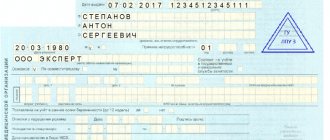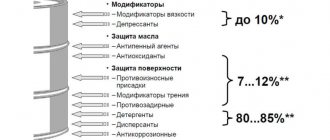Very often, professional tax lawyers and consultants are faced with the opinion that they simply do not understand the complex schemes of sellers of “paper” VAT and therefore do not recommend using it. The situation is just the opposite; we understand too well (not all, of course, but the majority) the entire internal “kitchen” of the “paper” VAT. And that is why we do not recommend contacting him.
Exclusive online course “Secrets of VAT optimization. And what you need to know about ASK VAT-2” by the author of an article by lawyer Kirill Soppa about the tools of tax authorities. You will understand the stereotypes and myths about the tax control system. Find out all the loopholes and holes. Learn methods of VAT optimization and competent tax planning.
Pay by card and start right now
Tax expert Kirill Soppa on his Yandex.Talk channel presented an analysis of all the myths and questions regarding VAT optimization schemes. The article turned out to be long because there are a lot of myths being spread. In this regard, at the beginning, in the form of a table of contents, there is a list of issues that are discussed in the article. You can only read what is interesting, but it is better in order.
- Why is VAT not legally optimized, unlike the income tax, although the principle of calculation seems to be the same for them - income minus expenses multiplied by the rate - it’s just that when calculating VAT, not all expenses are taken into account (only VAT ones)?
- How does ASK VAT-2 work? Why is it impossible to optimize VAT?
- How, despite the work of ASK VAT-2, do they continue to sell “paper” VAT? “Cashers” came up with a scheme to bypass ASK VAT-2?
- Why is “paper” VAT now sold separately from cash? Does this make the circuit safe?
- What are the various legal VAT optimization schemes that popular tax consultants sell at seminars?
- Sellers of “paper” VAT offer to buy deductions that do not create gaps in the VAT-2 ASK. Supposedly there are companies that have input VAT, but they don’t need it. This is true?
- Sellers of “paper” VAT sell a certain “export” VAT, which also does not create gaps according to the ASK VAT-2. Is it safe to buy?
- Is it even possible to buy real deductions from sellers of “paper” VAT? Are there ways to separate real deductions from artificial “paper” VAT?
- What happens if you buy an artificial “paper” VAT?
- An example of a real case when, at the request of a client, we analyzed the proposal of a “paper” VAT seller.
So, let's begin.
How does ASK VAT-2 work? Why is it impossible to optimize VAT?
Once it appears on your invoice issued by you to the Buyer, all VAT should appear in the budget. There are no grounds for reducing the tax base for VAT in the Tax Code. The operating principle of the ASK VAT-2 system is based on these features. The calculated tax has only two ways from you - either to the budget or to a declaration to another VAT payer. The system automatically builds this chain and sees the places where VAT is “leaked” online.
If before the introduction of the ASK VAT-2 system, the principle of evasion through shell companies was simple - such companies simply indicated in their VAT returns the amount of deductions approximately equal to the amount of VAT on sales. But after the implementation of the ASK VAT-2 system, all VAT taxpayers are required to submit, along with the VAT return, a transcript in electronic form of those companies that form the amount of deductions (purchases) and the VAT base (revenue). And submitting false declarations has become impossible; the system immediately sees that the specified deduction is not reflected in the sales book of the counterparty.
Reflection in accounting of goods at sales prices
The method of accounting for goods at sales price (i.e., taking into account the markup) is most often used in retail trade. In this case, the selling price is formed by adding a trade margin to the actual cost of goods without VAT (including VAT if the trading enterprise is a value added tax payer). VAT can be taken into account in the actual cost only if it is a non-refundable tax. For example, as with 6% simplified tax system.
When goods are accepted, a trade margin is immediately added to their cost, then they are displayed on account 41/2 (Dt 41/2 Kt 42). Accounting for revenue from sales (writing off goods) is carried out as goods are transferred to customers and payment documents (cash or sales receipt) are issued to them.
Any trading enterprise must provide in its accounting policies a method for forming the selling price. If the write-off of goods is recorded at the sales price, then it is necessary to fix in it the method of forming a trade margin, which is added upon acceptance of the goods to the purchase price to form the sales price.
Why is “paper” VAT now sold separately from cash? Does this make the circuit safe?
ASK VAT-2 is not the only weapon to combat VAT evasion and fly-by-night scams. An equally effective tool was the tightening of banking controls. If you read numerous Telegram chats of “cashers,” you can see that the average lifespan of a technical company through which money is transferred to current accounts is steadily decreasing and is already much less than three months. That is, they don’t even live for one tax period. It is not ASK VAT-2 that “kills” them, but the banks. An existing business is quite seriously different in payment structure from transit one-day businesses, and banks take advantage of this. Operating companies have employees, payments to suppliers of provisioning goods (office, clean water, cellular communications, Internet), rent payments, taxes. Of course, there are exception businesses that are more like transiters, but the regulator’s position here is very pragmatic - let us “crash” a couple of real businesses, but not a single “technical” one will leave.
This led to the fact that the classic “cashers” were divided into three types of specialization.
- Sellers of “paper” VAT. Their goal is to create the VAT funnel we talked about above. The main task facing these people is to create a bunch of fly-by-night companies, but not to spend money on them, because the banks will slam them faster than at least one declaration is submitted! They simply issue invoices and submit tax reports, confirming deductions for their customers. That is why this VAT is called “paper” VAT. And then they build various accounting chains between a bunch of their one-day accounts, including in reserve, so that if the client has problems, they can replace one deduction with another in previous periods. In addition, these people are constantly struggling with “nullifying” tax returns, providing documents for counter requests, and other problems.
- “Cashers” (droppers). These are the people who turn non-cash money into cash. Moreover, due to the tightening of banking and tax controls, they are no longer associated with VAT! They receive a VAT-free non-cash payment for their companies or individual entrepreneurs and turn it into cash. Either by rolling payments to drop physicists or from corporate cards through payment agents. Their main task is to look for drop physicists who are not yet included in the blacklists of banks, issue cards for them, carry the cache and transfer it to the customer.
- Transitors. These are the people who connect cash buyers and cashers. They accept a VAT non-cash with one purpose into their accounts and turn it into a non-VAT non-cash with a different purpose (which, for example, is suitable for a patent). Doing the so-called breaking and revolution. The main tasks of these people are to have connections in banks. They are constantly busy pulling their money out of the locks of various banks through writs of execution, decisions of the CCC and other methods. They prepare piles of documents for requests to banks.
Of course, there are people who can offer optimization of deductions and sell cash. But this most likely only means that they have found related partners and are simply reselling their services by increasing their 0.5-1%. This is evidenced by the fact that they always carry out deductions and cash sales from different “offices”.
At what rate is Belarusian VAT calculated?
When importing goods from Belarus, the Russian importer is obliged to pay import VAT, regardless of the territory of which country they were produced (this is evidenced by the letter of the Ministry of Finance of the Russian Federation dated September 8, 2010 No. 03-07-08/260). No exceptions are made for anyone: in this case, taxpayers pay VAT regardless of the chosen taxation system.
However, there is a list of goods exempt from import VAT. First of all, these are the lists given in Art. 150 of the Tax Code of the Russian Federation and the Decree of the Government of the Russian Federation dated April 30, 2009 No. 372, issued in accordance with it. The exemption under Art. 149 of the Tax Code of the Russian Federation.
For a list of cases when you do not need to pay VAT on imports from Belarus, see ConsultantPlus. Trial access to the system can be obtained for free.
For non-tax-exempt goods, the usual rates for import from Belarus are 20% or 10%, depending on the type of goods. A reduced 10% rate is provided for goods included in special lists established by the Government of the Russian Federation. In particular, for food products and children's products, such lists were approved by Decree of the Government of the Russian Federation dated December 31, 2004 No. 908. Imported products for which no benefits are established are taxed at a rate of 20%.
For shipments during the transition period (2018-2019), it was necessary to choose the VAT rate based not on the date of shipment of goods by the foreign seller, but on the date of their acceptance for registration by the Russian buyer. If the goods were shipped in 2022 and registered in 2019, the rate should have been 20%.
A ready-made solution from ConsultantPlus will help you calculate VAT on imports from Belarus. You can view the material for free by obtaining demo access to the system.
What happens if you buy an artificial “paper” VAT?
In fact, a break in the chain is not an independent basis for additional tax assessments. Here is an example of a case in which the tax authorities tried to charge the taxpayer with a gap. To which the court objected to the tax authority that the Tax Code does not say a word about ASK VAT-2, so they can use the data of this system only for their internal needs.
VAT poses the following risks:
- the likelihood of ordering an on-site tax audit seriously increases;
- additional VAT may be charged as part of a desk tax audit of the quarterly VAT return;
- collection incentive measures will be applied - employees of the district tax inspectorate will put pressure on the director of the organization - according to official statistics cited by the head of the Federal Tax Service of Russia in the annual report, budget revenues as a result of control and analytical activities outside the framework of tax audits almost doubled in 2017 and amounted to 56 billion rubles, and in 2018 almost 80 billion rubles.
To turn data on the gap into additional charges in court, tax authorities have to collect evidence of the unreality of transactions, and after Art. 54.1 of the Tax Code of the Russian Federation in the summer of 2022 - evidence of the unreality of the counterparty. Therefore, recently the tax authorities have shifted their main emphasis to the last method - forcing the taxpayer to voluntarily clarify his tax obligations, that is, to exclude all purchased “paper” VAT from the purchase book. This is clearly demonstrated by statistics.
What are the consequences for buyers of “paper” VAT?
Purchasing “paper” VAT is an illegal and risky method. Working with scammers and shell companies always entails a number of problems.
Violation of tax laws
The buyer of “paper” VAT violates tax laws. Based on the results of the audit, the tax office can:
- impose a fine in the amount of 20% of the unpaid amount (clause 1 of Article 122 of the Tax Code of the Russian Federation);
- impose a fine of 40% of the unpaid amount if they prove that the act was committed intentionally (clause 3 of Article 122 of the Tax Code of the Russian Federation);
- impose a fine on the official responsible for accounting in the amount of 5,000 - 10,000 rubles for the first violation or 10,000 - 20,000 rubles for a repeated violation (Article 15.11 of the Code of Administrative Offenses of the Russian Federation);
- bring to criminal liability under Art. 199 of the Criminal Code of the Russian Federation with a fine or imprisonment for up to 6 years.
"Virtual" stocks
When purchasing goods fictitiously, “non-existent” balances will appear in the buyer’s warehouse. As a result, the real picture of inventories of goods and materials in the warehouse is distorted, and in the event of an on-site inspection and inventory, inspectors will have many questions about the absence of declared inventories.
Risk of getting on the radar of the Federal Tax Service
Typically, the supplier of “paper” VAT does not physically supply goods, and he cannot provide services, since he has only one nominee director on his staff. During the audit, the tax office will pay attention to this and switch to all buyers of non-existent goods and services.
Inspectors can charge additional VAT to everyone who in one way or another interacted with a fly-by-night company.
Collection of “non-existent” debt through court
During the formal provision of services or transfer, all accounting documents are signed: invoices, acts, and so on, which confirm the fact of receipt of goods or acceptance of services. Based on primary documents, the buyer not only receives “input” VAT, but also increases accounts payable to the supplier.
The counterparty may go to court demanding payment, even if there was no agreement on this. And since he has all the signed documents in his hands, he is highly likely to win.
“Paper” VAT is a method known to the Federal Tax Service for understating taxes. By reducing the tax today, tomorrow you can subject the company to serious fines, and the manager and chief accountant to criminal punishment. Full payment of taxes and contributions is one of the conditions for the long existence of the company.
Optimize VAT in legal ways using the Kontur.Accounting service. The “VAT Calculation” tool will draw up a report in which it will show the preliminary amount and composition of VAT, suggest a list of primary documents that need to be requested from counterparties or transferred to them, and will mark errors in accounting that affect the amount of VAT. Test all the features of the service for free - Accounting gives new users a 14-day trial period.




